![]() ChiaroScuro presents
ChiaroScuro presents
![]() ChiaroScuro presents
ChiaroScuro presents
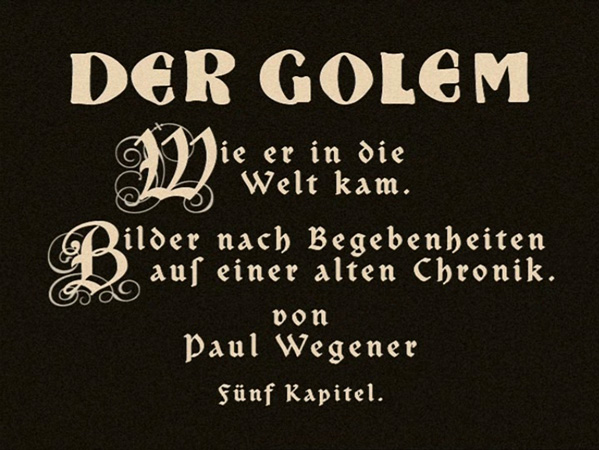
(The Golem | Le Golem)
by Paul Wegener, Carl Boese

Germany 1920
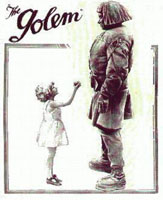 |
|
Director:
|
Paul Wegener, Carl Boese | |
|
Producer:
|
Paul Davidson | |
|
Production Companies:
|
Projektions-AG Union (PAGU), Berlin | |
|
Screenplay:
|
Paul Wegener, Henrik Galeen (from the novel by Henrik Galeen, based on a 17th-century legend) | |
|
Cinematographer:
|
Karl Freund (35 mm, 1.33:1, b/w, tinted) | |
|
Music Score:
|
Hans Landsberger; Aljoscha Zimmermann (music of the restored version) | |
|
Art Director:
|
Hans Poelzig, Kurt Richter | |
|
Set Designer:
|
Edgar G. Ulmer (uncredited) | |
|
Costume Design:
|
Rochus Gliese | |
|
First Assistant Director:
|
Carl Boese | |
|
Filming Locations:
|
UFA-Freigelände Berlin Tempelhof / UFA-Union Atelier Berlin Tempelhof, May-June 1920 | |
|
Cast:
|
Paul Wegener (Golem), Albert Steinrück (Rabbi Löw), Lyda Salmonova (Mirjam), Ernst Deutsch (Famulus), Otto Gebühr (Kaiser), Lothar Müthel (Graf Florian), Hans Sturm (Gemeindeältester), Max Kronert (Tempeldiener), Dore Paetzold (des Kaisers Kebse), Greta Schröder (Mädchen mit Rose), Loni Nest (das kleine Mädchen) |
|
|
Runtime:
|
Restauration 2000: 1953,5 m, 5 reels (tinted) = 85:50 min (at 20 fps); 95:30 min (at 18 fps, speed suggested by the Friedrich Wilhelm Murnau-Stiftung) | |
|
Premiere:
|
29 October 1920 (Berlin , UFA-Palast am Zoo) / 28 February 2002 (TV arte, restored version)
|

|
"Actor-director Paul Wegener made three films built around the mythical creature of Jewish legend: Golem was released in 1914, and a sequel of sorts, Der Golem und die Tänzerin, came out in 1917. This is the one film which has survived and is regarded among the landmarks of early German expressionism. ... Der Golem's main virtues are its visuals, particularly Karl Freund's expressive cinematography. The film is strongest in setting up its premise, using labyrinthine sets and shadowy figures to create an aura of doom and dread. When the mechanics of the story kick in, the film loses some of its suggestiveness and veers into melodrama.
— Tom Wiener, All-Movie Guide "Of the four extant versions of this perennial horror classic, Paul Wegener's 1920 version remains the best. Wegener both directs and stars in this extraordinarily vivid, magical, brooding film. His hulking claylike monster is an archetype, and the astonishing, angular, teetering sets by Hans Poelzig are an example of the nightmare world of the occult made breathtakingly concrete." "The oddest thing about The Golem (whose subtitle, "How He Came Into the World" distinguishes itself from several other Golem films, a couple of which were also directed by Wegener) is how much it relies on suggestion for effect. For all its lavish production values, it shows us very little in terms of its story's darker turns. ... As danger may lurk in the shadows of the frame, so too does it lurk in the dark possibilities of the tale. The Golem is not so much a horror film as a suggestive piece of fantasy. The film exists in a world where powerful rabbis conjure up spells and see visions of the future, where figures from the past directly alter events in the present. ... In fact, it might be rewarding to see the film as an intriguing counterpoint to F.W. Murnau's Nosferatu ..., where the physically frail, though certainly gruesome, vampire has powers that can transcend space, can cause madness and disease. The Golem, physically imposing as he is, is just a large, unthinking brute, at the mercy of those around him, even small children. The whisper-thin vampire and the burly automaton are in a sense the two great monsters of 1920s German cinema. "Paul Wegener had too strong a personality to be content with merely imitating [Max] Reinhardt's style. His treatment of the magical lighting-effects found at the Deutsches Theater was to adapt them to the needs of the cinema. From his previous work in natural settings he kept a fluidity of atmosphere which he managed to bring to his studio-made Golem. An airy lightness hangs about the shots of the flower-garlanded children playing in front of the ghetto gates. Wegener uses every one of [Max] Reinhardt's lighting-effects: the stars glinting against a velvety sky, the fierty glow of the alchemist's furnace, the little oil-lamp lighting a corner of the darkened room when Miriam appears, the servant holding a lantern, the row of blazing torches flickering in the night, and, in he synagogue, the light trembling over the prostate, indistinct forms wrapped in cloaks, with the sacred, haloed seven-branched candelabra emerging from the darkness." "Wegener was a cinematic visionary who strived to enhance his films with inventive camerawork. 'The real creator of the film must be the camera. Getting the spectator to change his point of view, using special effects to double the actor on the divided screen, superimposing other images — all this, technique, form, gives the content its real meaning,' he said in a 1916 lecture. 'Everything depends on the image, on a certain vagueness of outline where the fantastic world of the past meets the world of today. I realized that photographic technique was going to determine the destiny of the cinema. Light and darkness in the cinema play the same role as rhythm and cadence in music.' |
 |
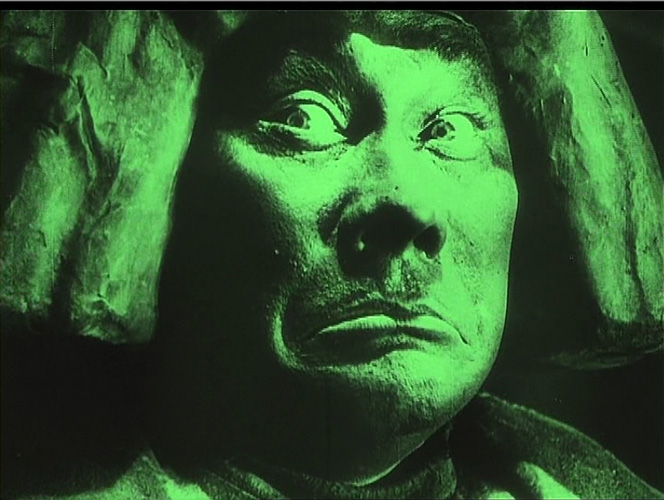
|
Comment:
|
The Eureka R2 transfer, done from the newly restored and most complete Bologna version, offers a much better quality in every aspect. But this does not mean that the transfer is perfect. There is quite a lot of edge enhancement, and heavy aliasing in movements on screen (see frame 5), possibly because the transfer was done from a NTSC-to-PAL conversion (there seems to be no PAL-speed-up) of the Kino edition (see below), or perhaps because the source material was licensed from Transit Film. Transit so far released Der Golem in Germany only on VHS (what a shame!), and it would be interesting to know, whether they gave the same master to Eureka and Kino for their DVD editions. The background noise of the intertitles indicates an analogue source. However, this still is a good-looking transfer and by far superior to all the public domain releases, including Elite Entertainment. The latter does not even offer a soundtrack. |
|
|
Other versions:
|
Available in the US: The Golem || The German Horror Classics Box Set Same source elements licensed from Transit Film as on the Eureka DVD. The Golem • Alpha Video • 85 min • Release Date: 24 Sep 2002 • Region 0 German Silent Masterworks: Nosferatu, The Last Laugh, The Golem • Slingshot Entertainment • 68 min • Release Date: 23 Oct 2001 Available in the UK:
The Golem • Dark Vision • 68 min |
Menu
(Elite Entertainment NTSC Region 0 left vs. Eureka Video PAL Region 2 right)
 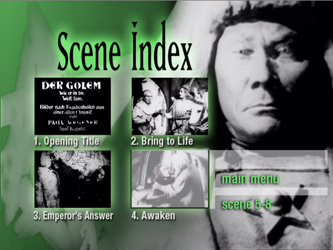 |
  |
Frame 1
(Elite Entertainment NTSC Region 0 top vs. Eureka Video PAL Region 2 bottom)
 |
 |
Frame 2
(Elite Entertainment NTSC Region 0 top vs. Eureka Video PAL Region 2 bottom)
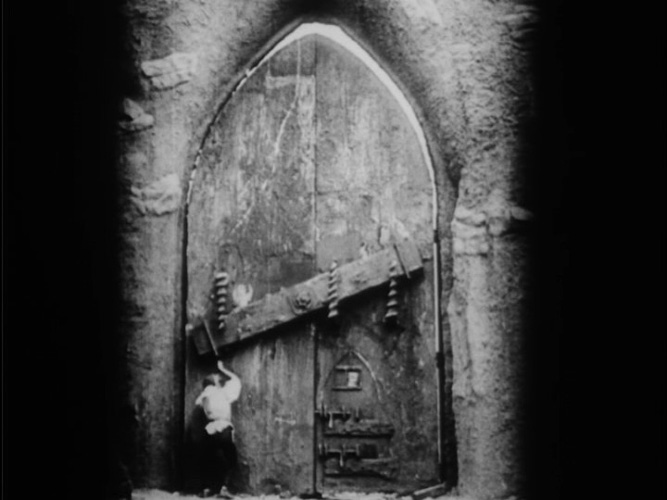 |
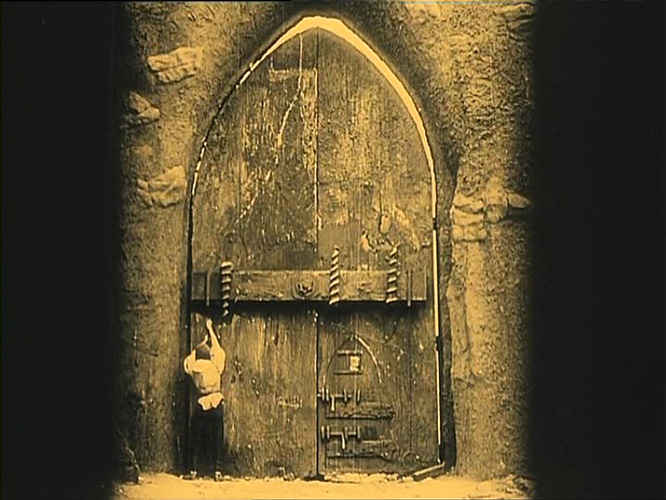 |
Frame 3
(Elite Entertainment NTSC Region 0 top vs. Eureka Video PAL Region 2 bottom)
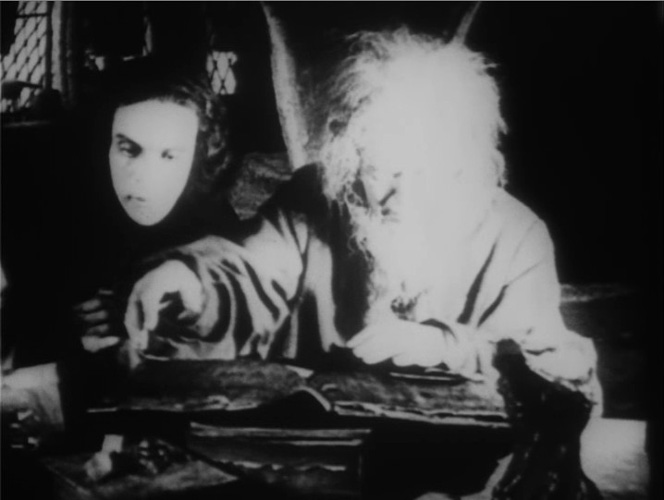 |
 |
Frame 4
(Elite Entertainment NTSC Region 0 top vs. Eureka Video PAL Region 2 bottom)
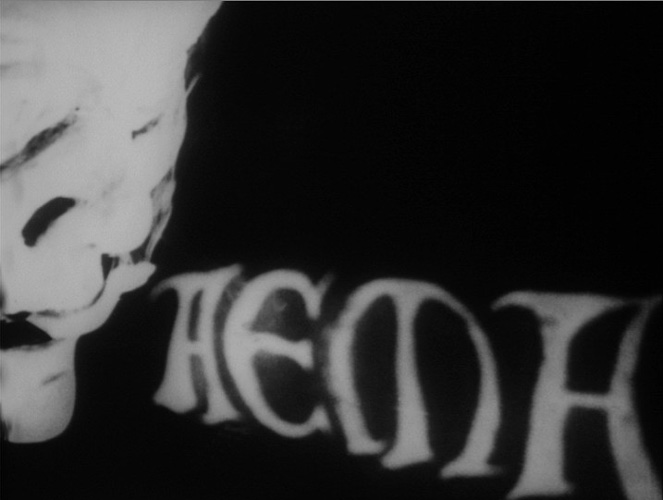 |
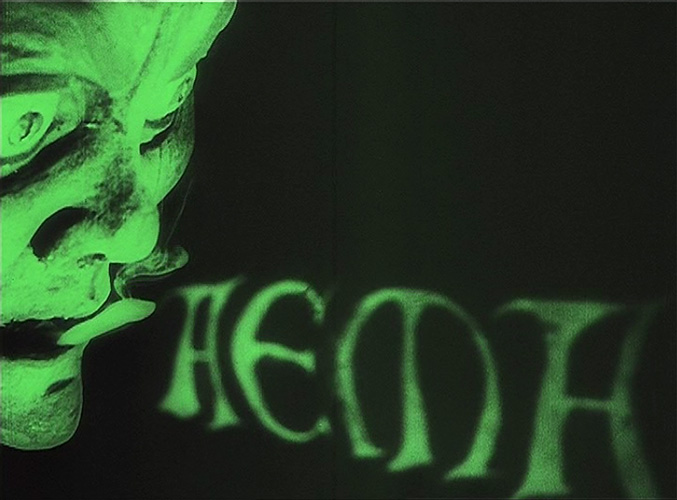 |
Frame 5
(Elite Entertainment NTSC Region 0 top vs. Eureka Video PAL Region 2 bottom)
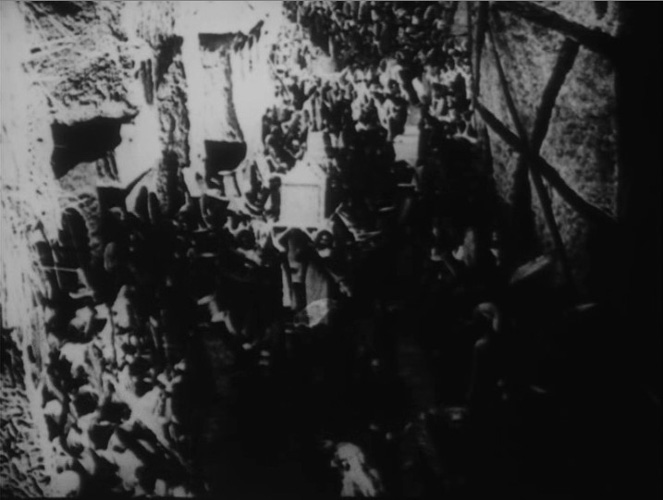 |
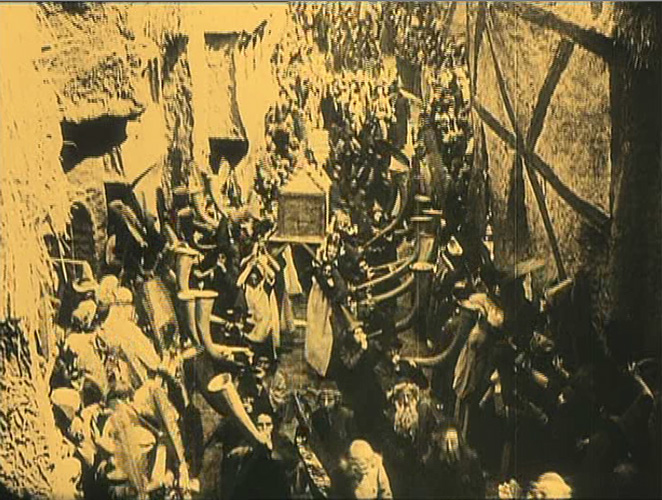
Detail of frame 5 Eureka Video. Notice the heavy aliasing. |
Frame 6
(Elite Entertainment NTSC Region 0 top vs. Eureka Video PAL Region 2 bottom)
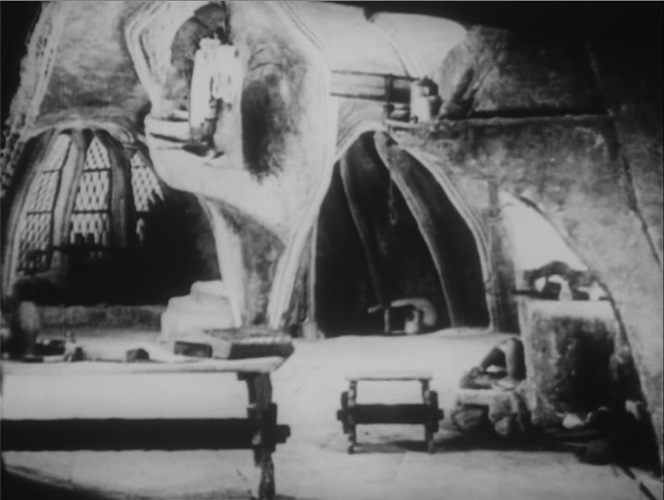 |
 |
Frame 7
(Elite Entertainment NTSC Region 0 top vs. Eureka Video PAL Region 2 bottom)
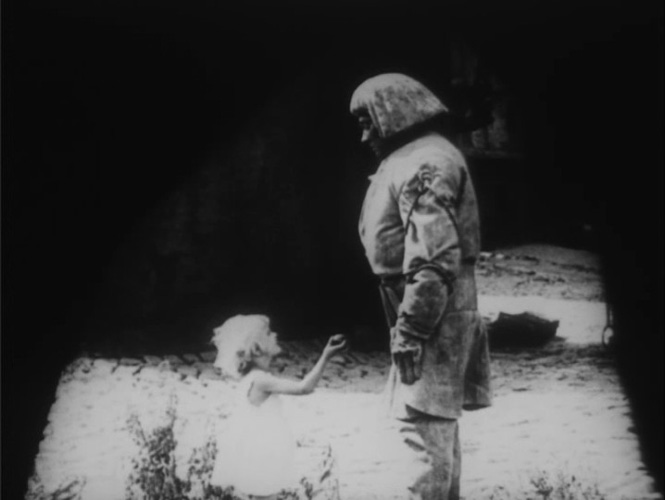 |
 |
Average Bitrate Elite Entertainment NTSC Region 0:
7.50 mb/s
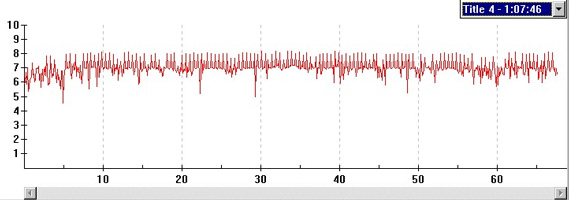
Average Bitrate Eureka Video PAL Region 2:
10.43 mb/s

|
This is a strictly non-professional and non-commercial DVD review. Don't expect industry reference work! All ChiaroScuro captures are taken under MacOS X.2 using VideoLAN and Snapz ProX. For further methodological remarks see DVDBeaver (click on "Methodology"): "We are not a lab and are doing a good a job as our time and energy permits. Thank you for understanding." |